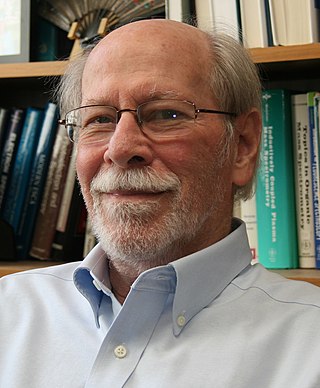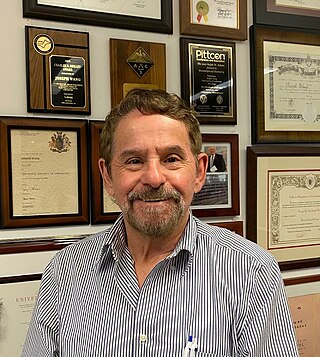A biosensor is an analytical device, used for the detection of a chemical substance, that combines a biological component with a physicochemical detector. The sensitive biological element, e.g. tissue, microorganisms, organelles, cell receptors, enzymes, antibodies, nucleic acids, etc., is a biologically derived material or biomimetic component that interacts with, binds with, or recognizes the analyte under study. The biologically sensitive elements can also be created by biological engineering. The transducer or the detector element, which transforms one signal into another one, works in a physicochemical way: optical, piezoelectric, electrochemical, electrochemiluminescence etc., resulting from the interaction of the analyte with the biological element, to easily measure and quantify. The biosensor reader device connects with the associated electronics or signal processors that are primarily responsible for the display of the results in a user-friendly way. This sometimes accounts for the most expensive part of the sensor device, however it is possible to generate a user friendly display that includes transducer and sensitive element. The readers are usually custom-designed and manufactured to suit the different working principles of biosensors.

Electrochemiluminescence or electrogenerated chemiluminescence (ECL) is a kind of luminescence produced during electrochemical reactions in solutions. In electrogenerated chemiluminescence, electrochemically generated intermediates undergo a highly exergonic reaction to produce an electronically excited state that then emits light upon relaxation to a lower-level state. This wavelength of the emitted photon of light corresponds to the energy gap between these two states. ECL excitation can be caused by energetic electron transfer (redox) reactions of electrogenerated species. Such luminescence excitation is a form of chemiluminescence where one/all reactants are produced electrochemically on the electrodes.
Muhammad Rasul Jan is a Pakistani chemist in the field of analytical chemistry. He served as Vice-Chancellor of University of Malakand from 14 April 2008 till 1 October 2012. He also served as Vice-Chancellor at University of Peshawar and currently he is serving as Vice-Chancellor at the University of Poonch in Rawalakot, Azad Kashmir. He has published extensively in national and international journals and has supervised many M.Phil. and PhD scholars in the field of Analytical Chemistry.

Allen Joseph Bard was an American chemist. He was the Hackerman-Welch Regents Chair Professor and director of the Center for Electrochemistry at the University of Texas at Austin. Bard developed innovations such as the scanning electrochemical microscope, his co-discovery of electrochemiluminescence, his key contributions to photoelectrochemistry of semiconductor electrodes, and co-authoring a seminal textbook.
Bioelectronics is a field of research in the convergence of biology and electronics.

Professor Anthony Peter Francis Turner, FRSC, usually known as Tony Turner, is a British academic specialising in the fields of biosensors and bioelectronics.
Elizabeth Anne Howlett Hall CBE, CChem, FRSC is a British Professor of Analytical Biotechnology at the Institute of Biotechnology, Department of Chemical Engineering and Biotechnology at the University of Cambridge.

Royce W. Murray was an American chemist and chemistry professor at the University of North Carolina at Chapel Hill. His research interests were focused on electrochemistry, molecular designs, and sensors. He published over 440 peer-reviewed articles in analytical, physical, inorganic, and materials chemistry, and trained 72 Ph.D students, 16 master’s students, and 58 postdoctoral fellows, 45 of whom have gone on to university faculty positions. He was named a fellow of the American Chemical Society in 2012, and was the inventor on three patents related to surface-modified electrodes.

Robert Mark Wightman is an electrochemist and professor emeritus of chemistry at the University of North Carolina at Chapel Hill. He is best known for his work in the areas of ultramicroelectrodes, electrochemistry, and neurochemistry. One of Wightman's most notable achievements is the development of the ultramicroelectrode and microelectrode voltammetry. At the same time as Wightman's innovations, the microelectrode was developed independently by Martin Fleischmann at the University of Southampton. In 2011, Wightman had the 192nd highest h-index, 74, of any living chemist. As of 2018, Wightman was an author of over 390 papers and had an h-index of 103.
Julie Macpherson is a professor of chemistry at the University of Warwick. In 2017 she was awarded the Royal Society Innovation award for her research into boron doped diamond electrochemical sensors.

Aptamers, single-stranded RNA and DNA sequences, bind to an analyte and change their conformation. They function as nucleic acids selectively binding molecules such as proteins, bacteria cells, metal ions, etc. Aptamers can be developed to have precise specificity to bind to a desired target. Aptamers change conformation upon binding, altering the electrochemical properties which can be measured. The Systematic Evolution of Ligands by Exponential Enrichment (SELEX) process generates aptamers. Electrochemical aptamer-based (E-AB) biosensors is a device that takes advantage of the electrochemical and biological properties of aptamers to take real time, in vivo measurements.
Shelley D. Minteer is an American academic and chemistry professor at the University of Utah. Minteer field of study focuses on the interface between biocatalysts and enzyme-based electrodes for biofuel cells and sensors.

Paper-based biosensors are a subset of paper-based microfluidics used to detect the presence of pathogens in water. Paper-based detection devices have been touted for their low cost, portability and ease of use. Its portability in particular makes it a good candidate for point-of-care testing. However, there are also limitations to these assays, and scientists are continually working to improve accuracy, sensitivity, and ability to test for multiple contaminants at the same time.

Ying Shirley Meng is a Singaporean-American materials scientist and academic. She is a professor at the Pritzker School of Molecular Engineering at the University of Chicago and Argonne Collaborative Center for Energy Storage Science (ACCESS) chief scientist at Argonne National Laboratory. Meng is the author and co-author of more than 300 peer-reviewed journal articles, two book chapter and six patents. She serves on the executive committee for battery division at the Electrochemical Society and she is the Editor-in-Chief for MRS Energy & Sustainability.
Carlotta Guiducci is an Italian bio-engineer. Her research is invested in bio-molecular analysis based on lab-on-a-chip devices. She is an Associate Professor at EPFL and head of the Laboratory of Life Sciences Electronics located at EPFL's Lausanne campus.

Chenzhong Li is a Chinese-born Canadian & American biomedical engineer, chemist, inventor, professor, and journal editor. Li is the co-Editor-in-Chief of the journal Biosensors and Bioelectronics (Elsevier) and the associate editors of journals RESEARCH (AAAS) and Biosensors (MDPI).
Dr. Shalini Prasad is a biological engineer, Cecil H. and Ida Green Professor of Systems Biology Science, and head of the Bioengineering Department at The University of Texas at Dallas. She was elected to the American Institute for Medical and Biological Engineering College of Fellows in February 2022 "for pioneering contributions in engineering sweat wearables for disease tracking and management for chronic diseases and prognostic monitoring in pandemics." Dr. Shalini Prasad has had a number of faculty positions at many universities. She is the co-founder of a small technology company called EnLiSense LLC. And her research consists of developing technology to monitor individuals to benefit the health industry.

Wei Gao is a Chinese-American biomedical engineer who currently serves as an assistant professor of medical engineering at the California Institute of Technology (Caltech). Gao has been a professor at Caltech since 2017 and is an associate editor of the journals Science Advances, npj Flexible Electronics (Nature), Journal on Flexible Electronics (IEEE), and Sensors & Diagnosis.

Sergey Piletsky is a professor of Bioanalytical Chemistry and the Research Director for School of Chemistry, University of Leicester, United Kingdom.

MicroRNA (miRNA) biosensors are analytical devices that involve interactions between the target miRNA strands and recognition element on a detection platform to produce signals that can be measured to indicate levels or the presence of the target miRNA. Research into miRNA biosensors shows shorter readout times, increased sensitivity and specificity of miRNA detection and lower fabrication costs than conventional miRNA detection methods.












